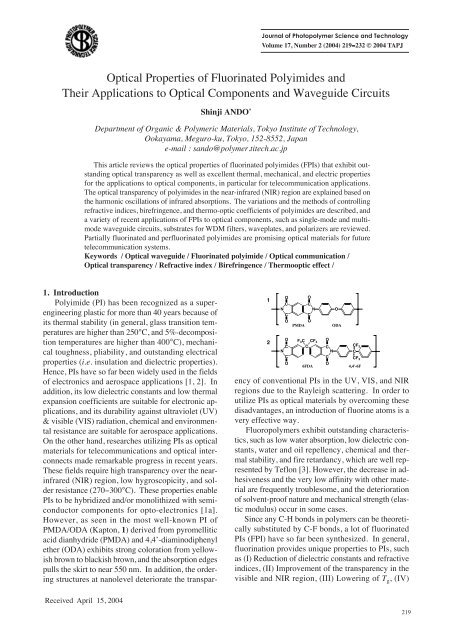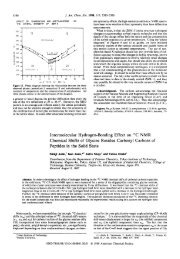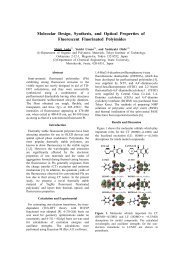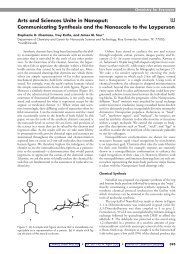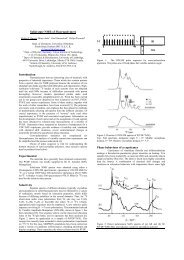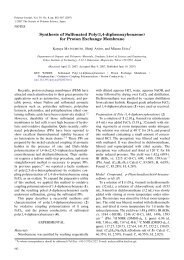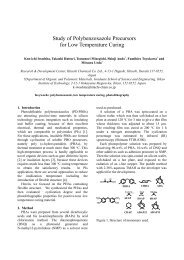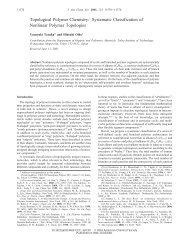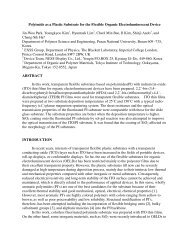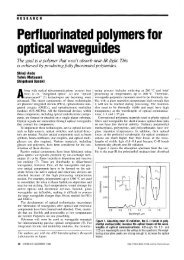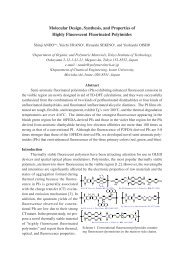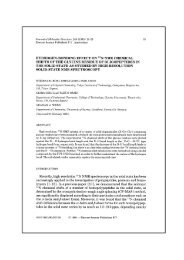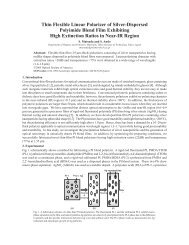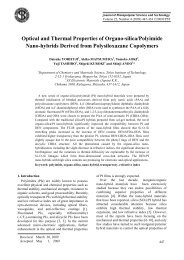Optical Properties of Fluorinated Polyimides and Their Applications ...
Optical Properties of Fluorinated Polyimides and Their Applications ...
Optical Properties of Fluorinated Polyimides and Their Applications ...
You also want an ePaper? Increase the reach of your titles
YUMPU automatically turns print PDFs into web optimized ePapers that Google loves.
all PI films, the absolute values <strong>of</strong> dn TE /dT are largerthan dn TM /dT, indicating remarkable anisotropy (dn TE /dT−dn TM /dT) in the TO coefficients in the range <strong>of</strong> −9 ~ −39 ppm/K. These anisotropy is not closely relatedto the degrees <strong>of</strong> refractive index or birefringence.This phenomenon may cause significant polarizationdependence in the performance <strong>of</strong> TOswitches, but this can also be used for polarizationsensitiveoptical filters or splitters etc.3 <strong>Applications</strong> <strong>of</strong> FPIs to <strong>Optical</strong> Use [34]3.1 Thin FPI-Film Substrates for MultilayerFiltersFlexible substrates for supporting “thin film filters”is a good example <strong>of</strong> the applications <strong>of</strong> outst<strong>and</strong>ingoptical transparency <strong>of</strong> FPI over the visible<strong>and</strong> NIR regions with good heat resistance, pliability,<strong>and</strong> good processability as thin films. For opticalcommunication applications, optical filters have afunction that they are transparent for specific wavelengthsbut reflective for other wavelengths. An opticalfilter consists <strong>of</strong> a dielectric multilayer, whichperforms transmission/reflection <strong>of</strong> light, <strong>and</strong> it isformed on a supporting substrate film. It is stronglyrequired that the thickness <strong>of</strong> a filter inserted into opticalcircuits, such as an optical fiber or opticalwaveguides, should be less than 20µm in order toreduce the radiation loss accompanying with a grooveformed in the optical circuits. For conventional bulktypefilters, multilayered thin film <strong>of</strong> TiO 2 <strong>and</strong> SiO 2is formed on an inorganic glass or silica substrate bysputtering, in which the cost for making thin film <strong>and</strong>grinding <strong>and</strong> polishing the substrate is rather high.On the other h<strong>and</strong>, since formation <strong>of</strong> FPI thin filmsis easy <strong>and</strong> economical by spin-coating [35], <strong>and</strong> theoptical transparency <strong>and</strong> heat resistance is excellent,FPI is the best material for substrates <strong>of</strong> multilayerfilters. Paying attention to the suitable properties <strong>of</strong>an FPI 7, thin film filters were fabricated using thisPI as a substrate. <strong>Optical</strong> filters having a function <strong>of</strong>1.3 µm-transmission / 1.55 µm-reflection were producedusing inorganic glass <strong>and</strong> FPI substrates, <strong>and</strong>almost the same properties were obtained. At present,thin PI film filters are produced <strong>and</strong> widely used inthe WDM modules for optical surveillance systemsin fiber-optics communications.3.2 Thin FPI-Film Waveplates“Thin film polyimide waveplate” is a good example<strong>of</strong> application using the large birefringence nature<strong>of</strong> FPIs having rigid-rod molecular structures withoutst<strong>and</strong>ing optical transparency. Silica-based planarlightwave circuits (PLCs) formed on Si substratesare widely used for optical communications becauseSpinCoatingDryingSolventPeelingPoly(amic acid)SolutionSubstratePoly(amic acid)FilmCuttingThermal Curing<strong>of</strong> their high performance <strong>and</strong> mass-productivity.However, the optical components using interference<strong>of</strong> light frequently show apparent polarization dependenceresulting from the birefringence <strong>of</strong> opticalwaveguides, <strong>and</strong> this had been a serious problem [36].As a technique for solving this, the polarization modeexchanging method which inserts a half-waveplate atthe center <strong>of</strong> optical path <strong>of</strong> PLC was proposed. However,when using a conventional half-waveplate madeby quartz (92 µm-thick), excess insertion loss (radiationloss) is more than 5 dB due to the large thickness.In order to reduce the loss, the thickness <strong>of</strong> awaveplate should be reduced, <strong>and</strong> thus, it is necessaryto produce a waveplate using highly birefringentmaterials. Moreover, ease at insertion, outst<strong>and</strong>ingoptical transparency at the operating wavelength, <strong>and</strong>high reliability over high temperature <strong>and</strong> high humidityare required as same as for optical filters. Andoet al. [37-40] focused on the rigid-rod molecule structure<strong>of</strong> a FPI 7. Although PI thin films can be easilyformed by spin-coating <strong>of</strong> polyamic acid solution (precursor)on a substrate followed by heating, the filmsthus produced is optically isotropic in the film plane.Hence, no in-plane birefringence (∆n // =∆n TE1 −∆n TE2 )is generated. Then, spin-coated polyamic acid solutionwas partially dried at a low temperature, <strong>and</strong>peeled from the substrate. The film was fixed to ametal frame by two sides <strong>of</strong> the longer direction. ThePI molecules are spontaneously orientated along thefixed direction during thermal imidization at 350°C,<strong>and</strong> thus large birefringence (∆n // =0.053) was generatedin the film plane. (Fig. 7). The magnitude <strong>of</strong>birefringence is controllable with high precision bychanging the curing conditions, in particular the highestimidization temperature. A PI waveplate exhibitinga large ∆n (0.18), that is 20 times larger than quartz,is producible by using this technique. As a result, thethickness <strong>of</strong> a novel PI waveplate <strong>of</strong> 14.5 µm for an TE2n TE1Metal FrameFig. 7 Method <strong>of</strong> preparing polyimide waveplate usingthe spontaneous orientation behavior [37-40].224
Transmittance (%)Input Waveguidesλ1 • • • λn<strong>Optical</strong> InputSlab waveguidesOutput Waveguidesλn<strong>Optical</strong> Outputλ1100a) b)80Poly(amic acid) Filmdissolving Silver NitrateThermal Curing60<strong>and</strong> UniaxialDrawing (~320˚C)40T ⊥Arrayed waveguidesPolyimide half waveplateGroove<strong>Optical</strong> Axis(45 degree)SubstratePrecipitation <strong>of</strong> SilverNanoparticles HavingAnisotrpic Shapes2000.6 0.7 0.8Fig. 9 a) Preparation <strong>of</strong> silver nanoparticle dispersed<strong>and</strong> uniaxially drawn polyimide film <strong>and</strong> b) polarizedtransmission spectra <strong>of</strong> the films obtained [44-46].wavTransmission (dB)(a) without PI waveplate0-10-20-30-40-50TETM1.554 1.555Wavelength (µm)(b) with PI waveplate0Fig. 8 Insertion <strong>of</strong> a thin polyimde waveplate into agroove formed in an arrayed waveguide grating (AWG)(top), <strong>and</strong> the effect <strong>of</strong> elimination <strong>of</strong> polarization dependenceby the PI waveplate (bottom) [31].-10-20-30-40-501.554 1.555Wavelength (µm)wavelength <strong>of</strong> 1.55 µm is about 1/6 <strong>of</strong> conventionalquartz waveplate. Accordingly, the resulting drasticdecrease in the thickness <strong>of</strong> half-waveplate alsosharply reduced the insertion loss to less than 0.3 dB.Furthermore, since it has outst<strong>and</strong>ing heat resistance(350°C) <strong>and</strong> good pliability, PI waveplates contributedto the improvement in reliability <strong>and</strong> low costs<strong>of</strong> optical components. Matsuda et al. [41, 42] clarifiedthat the intrinsic birefringence (the birefringencewhen all polymer chains are uniaxially orientated inone-direction) <strong>of</strong> PIs having rigid structures(0.33∼0.51) can far exceed the values <strong>of</strong> calcite (0.172)<strong>and</strong> rutile (titanium dioxide : 0.287). Further applications<strong>of</strong> the highly birefringent nature <strong>of</strong> uniaxiallydrawn FPIs to optical components are expected.An example <strong>of</strong> application <strong>of</strong> a PI half-waveplateto arrayed waveguides multiplexer (AWG) is shownin Fig. 8. A waveplate is inserted into a thin grooveformed at the center <strong>of</strong> lightpath <strong>of</strong> the AWG circuit<strong>and</strong> is being fixed with optical adhesive. The peakwavelengths <strong>of</strong> optical output differ between the TE<strong>and</strong> TM polarizations after wavelength separation dueto the intrinsic birefringence <strong>of</strong> the opticalwaveguides. However, by inserting a PI waveplate,the peak wavelengths <strong>of</strong> the AWG coincide for TE<strong>and</strong> TM polarizations, <strong>and</strong> thus the polarization dependence<strong>of</strong> the whole circuit was eliminated. Theexcess loss <strong>of</strong> the waveplate was estimated as 0.26dB, which is 1/15 or less than the loss with a quartzwaveplate [38]. Moreover, the degree <strong>of</strong> polarizationconversion <strong>of</strong> a FPI waveplates is more than 25dB <strong>and</strong> the amount <strong>of</strong> reflective attenuation is below−30 dB [39]. These performance suffices the dem<strong>and</strong>sfor dense WDM systems that will be introduced inthe near future.Since the FPI waveplates are very effective ineliminating the polarization dependence <strong>of</strong> interferedtypelightwave circuits, they can also be used for directionalcouplers, asymmetrical Mach-Zehnder interferometer-typewavelength multiplexers, opticalbranching circuits, <strong>and</strong> wavelength dispersion equalizers.Moreover, Sawada et al. [43] have fabricated aultrathin film reflective-type FPI waveplate with athickness <strong>of</strong> 5 µm. A 0.1 µm-thick gold film wasformed on a FPI waveplate by sputtering, <strong>and</strong> thenthe hybrid film functions as a reflective waveplate.LiNbO 3 is fragile as optical waveguide material, <strong>and</strong>it is very difficult to form a thin glove. A PI reflectivewaveplate was attached at the end <strong>of</strong> waveguides,<strong>and</strong> thus the polarization dependence was completelyeliminated, <strong>and</strong> miniaturization <strong>of</strong> components <strong>and</strong>switching at a low voltage were attained.3.3 Thin FPI-Film PolarizersBy using FPI films that exhibit excellent opticaltransparency <strong>and</strong> pliability, optical components canbe fabricated by small sizes. Polarizer is a fundamentaloptical component that transmits only a specificlinear polarization. Conventionally, thin filmpolarizers have been fabricated by uniaxially drawninorganic glass containing ultrafine- or nano-particles<strong>of</strong> metals (silver <strong>and</strong> copper). Ando et al. [44] dissolvedsilver nitrate in a polyamide acid (PAA) solution<strong>of</strong> 7, <strong>and</strong> formed a PAA film followed by uniaxialdrawing during thermal curing. They found out thatsilver nanoparticles having a long <strong>and</strong> slender form(whisker shape) were precipitated <strong>and</strong> deposited inthe films after imidization. The precipitation <strong>of</strong> silvernanoparticles having anisotropic shapes were promotedby the high degree <strong>of</strong> orientation <strong>of</strong> polyimidechain that is well reflected to the large birefringence<strong>of</strong> FPIs. The uniaxially drawn FPIs function well as225
50 µmSingle-mode polyimide waveguidesFig. 10 A variety <strong>of</strong> polyimide waveguides (the diameters<strong>of</strong> the cores for the single <strong>and</strong> multi-modewaveguides are 8 <strong>and</strong> 50 µm, respectively).very transparent but highly anisotropic media. Sincethe fundamental absorption wavelength <strong>of</strong> the plasmonresonance absorption <strong>of</strong> Ag nanoparticles differsgreatly in the directions parallel <strong>and</strong> perpendicularto the elongation direction, the high polarizationcharacteristic (larger dichroic ratios) can be achievedin the visible <strong>and</strong> NIR regions. Recently, Matsuda etal. [45, 46] optimized the heat treatment conditions<strong>and</strong> the atmosphere <strong>of</strong> imidization, <strong>and</strong> produced thinfilm (14.5 µm-thick) FPI polarizers whose extinctionratios are larger than 25 dB (500:1) at a wavelength<strong>of</strong> 0.85 µm (Fig. 9).3.4 Planar <strong>Optical</strong> Waveguides <strong>of</strong> FPIs<strong>Optical</strong> waveguide is a fundamental componentwhich confines an optical signal in a specific domain,<strong>and</strong> the light propagates from the incident edge to theother edge. The domain having a high refractive indexis called ‘core’ which are surrounded by a domainhaving a lower refractive index called ‘cladding’.Waveguides can be roughly divided into twogroups, “planar (slab) waveguides” <strong>and</strong> “channelwaveguides”. The former has a spread waveguidesat two dimensions. In the latter, light propagates inone dimension due to the confinement <strong>of</strong> light in theircores.140 µmWaveguides formed on Si-substrateMulti-mode polyimide waveguidesFilm waveguidesThe idea to use PIs for optical waveguide materialsis not new. In 1982, Furuya [47] at the Bell Lab <strong>of</strong>AT&T fabricated a semiconductor laser with slabwaveguides using conventional polyimides (DuPontPyralin PI-2555). The structure <strong>of</strong> waveguides wereprepared by two cladding layers with a low refractiveindex in the upper <strong>and</strong> lower sides <strong>of</strong> a planarwaveguide (core layer), in which light was confinedin the vertical direction. The propagation loss <strong>of</strong> thisoptical waveguides was reported as 3 dB/cm at awavelength <strong>of</strong> 0.5 µm. After that, various kinds <strong>of</strong> PIoptical waveguides have been fabricated <strong>and</strong> examinedfor the purpose <strong>of</strong> optical interconnection in optoelectronicintegrated circuits (OEIC). Since most<strong>of</strong> the researches have been in the electronics field,conventional PIs that have been used for insulator<strong>and</strong> aerospace applications were used for waveguidefabrications, but a few chemists tried to develop novelpolyimides which are suitable for optical uses. In1993. Kowalczyk et al. [48] produced planar slabwaveguides using a photosensitive FPI (AmocoUltradel 9020D) formed on a thermally oxizided Siwafer. They reported that the optical loss was 0.4dB/cm in actual measurement at the wavelength <strong>of</strong>0.8 µm <strong>and</strong> 0.3 dB/cm as a predicted value at 1.3 µm.Moreover, Franke et al. [49] fabricated planarwaveguides using two kinds <strong>of</strong> FPIs : 6FDA/4-4'-6F(2) <strong>and</strong> 6FDA/3,3'-6F (4). They aimed to apply thewaveguides to humidity sensor utilizing the good sensitivity<strong>of</strong> the propagation characters <strong>of</strong> PI waveguidesto humidity.3.4.1 Channel-Type <strong>Optical</strong> WaveguidesIn recent years, planar optical waveguides componentsincluding planer lightwave circuits for opticalwiring <strong>and</strong> interconnections have been fabricatedusing technologies for fine patterning <strong>and</strong> processing<strong>of</strong> PI thin films formed on substrates. In addition, a(a)λ = 0.63µm(c)λ = 1.3µmAirCoreFig. 11a The crosssectionalview <strong>of</strong> the core<strong>of</strong> a single-mode FPIwaveguide [51,52,54].(b)λ = 0.85µm(c)λ = 1.55µmCladdingSi-substrate10 µmFig. 11b The optical power distribution (near fieldpatterns) <strong>of</strong> a polyimide waveguide measured atdifferent wavelengths. Single-mode operation is attainedat 1.3 <strong>and</strong> 1.55 µm [51,52,54] .226
1011OCNCOPMDAOCNCOPMDAOCNCOOCNCOF 3 CO OCF 3ATPTF F F 3 CO OCF 3 F FATPB<strong>Optical</strong> Loss (dB)2015105L=5cmPerfluorinated Polyimide<strong>Fluorinated</strong> Polyimide12OCNCOF 3 C CF 3OC CCF 3N C PSCCF 3O6FDA4,4'-6Fvariety <strong>of</strong> optical circuits combining straight lines,curves, branches, <strong>and</strong> intersections have been reported.These optical wirings are composed <strong>of</strong> “channel-typeoptical waveguides” that can be dividedroughly into “ridge-type optical waveguides” in whichthe core is exposed, <strong>and</strong> “embedded-type opticalwaveguides” in which the core is embedded by sheathmaterial (cladding). For advanced optical circuits <strong>and</strong>interconnects, only the embedded-type can be usedbecause these require the single-mode operation.3.4.2 Waveguides Fabricated by Dry-EtchingIn 1988, Sullivan et al. [50] formed PI thin filmsthat were specially developed for optical use on athermally oxidized Si substrate, <strong>and</strong> produced a 1x4branch-type lightwave circuits, <strong>and</strong> an 8x8 opticalmatrix circuit using silicone oxide <strong>and</strong> two-layer mask<strong>of</strong> photoresist. At a wavelength <strong>of</strong> 0.83 µm, the propagationloss <strong>of</strong> 0.15 dB was reported for a straight line,<strong>and</strong> 0.4 dB for a 45° bent. In addition, the opticallosses <strong>of</strong> these circuits were 0.03 dB for a 1x2 branch,0.3 dB/cm for an intersection, <strong>and</strong> 0.4 dB for a 90°bent. Considering their multi-mode operation, thelosses were surprisingly low. Matsuura et al. [51]produced ridge-type PI waveguides using copolymers<strong>of</strong> 5 <strong>and</strong> 7 on thermally oxidized Si substrates. BothFPIs exhibit excellent optical transparency at the opticalcommunication wavelengths in NIR region.They reported the propagation loss for a straight linewas 0.3 dB/cm, <strong>and</strong> the connection loss with a silicafiber was 0.5 dB at 1.3 µm. Moreover, they fabricatedembedded-type optical waveguides for thesingle-mode <strong>and</strong> multi-mode operations using copolymers<strong>of</strong> 5 <strong>and</strong> 7 whose refractive indices were preciselycontrolled by varying the copolymerizationratio [52] (Fig. 10). The magnified core <strong>of</strong> an embedded-typesingle mode waveguide <strong>and</strong> the powerdistributions <strong>of</strong> the optical output on the facet (nearfieldpatterns) <strong>of</strong> the optical waveguides are shown in00.7 0.9 1.1 1.3 1.5 1.7Wavelength (µm)Fig. 12 <strong>Optical</strong> loss spectra <strong>of</strong> single-modewaveguides prepared by perfluorinated polyimide <strong>and</strong>partially fluorinated polyimide [58].Fig. 11. The operation is multi-mode at the wavelengths<strong>of</strong> 0.63 µm <strong>and</strong> 0.85 µm, in which the spreadingoptical power is distributed in complicated ways.However, typical Gaussian distributions are observedat the center <strong>of</strong> the cores with the strongest powerdistribution at the wavelengths <strong>of</strong> 1.3 <strong>and</strong> 1.55 µm,which indicates the single-mode operation. Thepropagation loss <strong>of</strong> this single-mode opticalwaveguides was 0.27 dB/cm at 1.3 µm, <strong>and</strong> the connectionloss with a single-mode optical fiber was 0.25dB.Since FPIs exhibit outst<strong>and</strong>ing heat resistance <strong>and</strong>low water absorptivity, optical waveguides fabricatedusing FPIs are also excellent in thermal stability <strong>of</strong>optical loss <strong>and</strong> moisture resistance. Kobayashi et al.[53] evaluated the heat <strong>and</strong> moisture resistance <strong>of</strong>single mode embedded-type waveguides produced bycopolymers <strong>of</strong> 3 <strong>and</strong> 5. The optical losses did notchange after annealing at 380°C for 1h <strong>and</strong> after keepingat a relative humidity <strong>of</strong> 85 % at 85°C for 200 h.The above mentioned FPI optical waveguides areusually fabricated on Si substrates like silica-basedPLCs. However, they can also be used as self-st<strong>and</strong>ingfilm-type waveguides by removing substratesbecause <strong>of</strong> the pliability <strong>of</strong> FPIs (Fig. 10). The residualstress originating from the mismatch <strong>of</strong> thermalexpansion with the substrate can be released byadditional annealing. The polarization dependent loss<strong>and</strong> the birefringence can also be reduced by annealing.The propagation loss <strong>of</strong> FPI film waveguideswas reported as 0.3 dB/cm at 1.3 µm, <strong>and</strong> the polarizationdependent loss was below 0.1 dB/cm. Moreover,the measured birefringence (∆n) is almostequivalent to silica-based optical waveguides. Thevalue <strong>of</strong> 9x10 -5 for ∆n is 1/100 or less than those <strong>of</strong>FPI waveguides formed on Si substrates [54].As an example <strong>of</strong> application <strong>of</strong> optical waveguides227
using FPIs with different molecule structures, Kim etal. [55] formed a thin film by UV irradiation <strong>and</strong> heattreatment using photo-curable FPIs, <strong>and</strong> they tried t<strong>of</strong>abricate channel-type optical waveguides by ICP (InductivelyCoupled Plasma) etching <strong>of</strong> oxygen usinga SiO 2 mask. Moreover, Han et al. [56] synthesizedcopolymer <strong>of</strong> FPIs with different fluorine contents(10 <strong>and</strong> 11), <strong>and</strong> they fabricated embedded-type opticalwaveguides. The refractive index control range<strong>of</strong> this copolymer is 1.5397 to 1.5671 at 1.55 µm forthe TE mode, <strong>and</strong> a difference in refractive indices<strong>of</strong> 1.7% was attained. The propagation loss for theembedded-type optical waveguides (core depth <strong>and</strong>width were 1.6 µm <strong>and</strong> 6 µm, respectively) was below0.5 dB/cm at 1.55 µm. On the other h<strong>and</strong>, Han etal. [57] synthesized copolymer <strong>of</strong> 3 <strong>and</strong> fluorine- <strong>and</strong>chlorine-containing PIs, <strong>and</strong> fabricated embeddedtypewaveguides. The refractive indices <strong>of</strong> PIs increasewith the increase in the chlorine content, <strong>and</strong>they can be controlled within 3.4 % from 1.5176 to1.5714 in the TE mode at 1.55 µm. The propagationloss <strong>of</strong> the embedded-type waveguides fabricated fromthis material was below 0.4 dB/cm <strong>and</strong> the polarizationdependence loss was below 0.1 dB/cm at 1.55µm.Since a perfluorinated PI (6) show no absorptionpeaks in NIR region, very high transparency is expectedboth at 1.31 <strong>and</strong> 1.55 µm, which is very advantageousas a waveguide material. Very recently,Kagei et al. [58] fabricated embedded-typewaveguides using perfluorinated PIs for the core <strong>and</strong>cladding, <strong>and</strong> the single mode operation was confirmed.The propagation losses were 0.10 dB/cm forTE mode <strong>and</strong> 0.18 dB/cm for TM mode. As shownin Fig. 12, no absorption peaks are observed throughoutNIR region except for the absorption perk at 1.39µm which is attributable to the 2nd harmonics <strong>of</strong>stretching vibration <strong>of</strong> O-H <strong>of</strong> water absorbed in thewaveguides <strong>and</strong>/or the 4 th harmonics <strong>of</strong> the asymmetricalvibration <strong>of</strong> imide C=O.3.4.3 Channel Wavegudies by Photosensitive FPIsThe above-mentioned channel-type FPIwaveguides have been fabricated by fine patterning<strong>and</strong> processing by reactive ion etching (RIE) techniqueusing oxygen gas with lithography using photoresists.On the other h<strong>and</strong>, photo-sensitive moleculescan be mixed or photo-sensitive moieties canbe introduced into the main chain or side chain structures<strong>of</strong> FPIs. This means that channel-typewaveguide can be easily fabricated by exposure <strong>and</strong>development <strong>of</strong> FPIs without RIE processes. Beuhleret al. [59] fabricated channel-type waveguides usingFPIs, in which photo-sensitive cross-linkable moietyCoreCladdingCu-Polyimidemulti-layerinterconnectionboardSubstratePolyimide WaveguidesElectronic CircuitElectric signal boardCu-Pl multilayerCeramic multilayerFig. 13 An example <strong>of</strong> opto-electronic multi-chipmodule (OE-MCM) [63].was incorporated in the the main chain by copolymerizationwith FPI (12). In this material system, therefractive index control <strong>of</strong> the core <strong>and</strong> cladding wasattained by substituting fluorinated groups with alkylgroups. The propagation loss <strong>of</strong> the fabricated embedded-typewaveguides was below 1 dB/cm at 1.55µm.3.4.4 Channel Waveguides by Electron BeamAs mentioned in Section 2.3, when electron beamis irradiated to a FPI (5), the refractive index increasesdue to the elimination <strong>of</strong> fluorine atoms without loosingthe good transparency. Using this phenomenon,Maruo et al. [60, 61] irradiated electron beam on acore layer <strong>of</strong> FPI thin film, <strong>and</strong> produced channeltypewaveguides. Unlike to the waveguides fabricatedby other methods, the core produced by electronbeam exhibits specific refractive-index distributionoriginating from the diffusion <strong>and</strong> absorption <strong>of</strong>high-energy electrons to the PI thin layer.3.4.5 Channel Waveguides by EmbossingFor producing channel-type FPI waveguides economically<strong>and</strong> in large quantities, several methodsusing metallic molds, stamps, or polymeric transfermolds are proposed. Shiota et al. [62] examined amethod to fabricate FPI waveguides using a transfermold made <strong>of</strong> PI. The exfoliation layer <strong>of</strong> SiO 2 wasdeposited on a FPI transfer mold in advance, <strong>and</strong> aprecursor solution <strong>of</strong> FPI (copolymer <strong>of</strong> 3 <strong>and</strong> 5) wasspin-coated on it, <strong>and</strong> then a cladding film havingtrenches that can be used for cores was obtained. Filmtypeoptical waveguides were prepared by spin-coating<strong>and</strong> following thermal imidization <strong>of</strong> the core <strong>and</strong>upper cladding. The propagation loss <strong>of</strong> the embedded-typewaveguides fabricated by this method was0.3 dB/cm3.5 <strong>Applications</strong> <strong>of</strong> FPI Waveguides to <strong>Optical</strong>InterconnectionsThe connection technology between optical fibers228
1.3/1.55µm InputWDM filter1.3µm OutputMultiplexing Circuit Mutual In/Out Circuit 1.55µm1.55µm1.3µm1.3/1.55µm1.3µm1.3µm1.55µm Output FPI waveguides Adhesive1mmFig.14 1x2 wavelength division multiplexer [68].Fig.15 An architecture <strong>of</strong> <strong>Optical</strong> NetworkingUnit (ONU) installed in subscribers.<strong>and</strong> opto-electronic components for modules in whichLSI chips for signal processing are mounted (OEIC)is very important as an application <strong>of</strong> opticalwaveguides. Shimokawa et al. [63] fabricated multimoderidge-type optical waveguides using FPI copolymerson a multilayer electronic wiring substrate(copper-PIs <strong>and</strong> ceramics-PIs wiring boards) in 1993.They tried to produce an opto-electronic mixed-loadingopto-electronic multi-chip module (OE-MCM)(Fig. 13). The propagation loss <strong>of</strong> the multi modewaveguides was 0.4 dB/cm at the wavelength <strong>of</strong> 1.3µm. Since the diameter <strong>of</strong> the cores for multi-modewaveguides is as large as 50 µm, deep etching technologywas needed for the precise processing <strong>of</strong>waveguides. It was achieved by RIE technique usingoxygen plasma <strong>and</strong> a titanium mask for a high selectionratio. Moreover, Koike et al. [64] produced a45° mirror to facet <strong>of</strong> optical waveguides by leaningthe above-mentioned ridge-type optical waveguidesby 45° during perpendicular etching. Using opticalwaveguides with a 45° mirror, vertical surface-typephotodetectors (PD) <strong>and</strong> vertical-cavity surface-emittinglaser (VCSEL) can be directly mounted on thesurface <strong>of</strong> waveguide circuits.3.6 <strong>Optical</strong> Circuits <strong>of</strong> FPI Waveguides<strong>Optical</strong> waveguides is not only used for simpleoptical interconnections between module <strong>and</strong> chipsbut can form various types <strong>of</strong> functional componentsby designing optical circuits. Kobayashi et al. [65]fabricated various types <strong>of</strong> bent waveguides using copolymers<strong>of</strong> FPI 3 <strong>and</strong> 5 on Si substrates with varyingthe curvature radius. They showed that the minimumbent radius (the minimum curvature for confining lightin the core) can be minimized by increasing the differencein refractive indices between the core <strong>and</strong> cladding.Ukechi [66] examined optical losses in basicwaveguide components, such as a straight line, S-curve, <strong>and</strong> Y-branch, <strong>and</strong> confirmed validity <strong>of</strong> application<strong>of</strong> FPI waveguides to hybrid optical integratedcircuits.3.6.1 Directional CouplersBy combining waveguides <strong>of</strong> bent structures <strong>and</strong>straight lines, a directional coupler, a fundamentaloptical circuit component, was produced byKobayashi et al. using copolymers <strong>of</strong> FPI 3 <strong>and</strong> 5[67]. Mutual interference <strong>of</strong> propagating signals isgenerated at the joint part, at which two opticalwaveguides adjoined, <strong>and</strong> the optical output for thethrough port <strong>and</strong> the crossing port can be changed bycontrolling the interval <strong>and</strong> interaction length <strong>of</strong> thejoint part. A directional coupler whose separationratio is set to 1:1 is called a 3 dB coupler, <strong>and</strong> it is atypical 1x2 optical branch component.3.6.2 Wavelength-Division Multiplexers (WDM)Katada et al. [68] produced a filter-insertion-type1x2 two-wavelength division (1.3/1.55 µm) multiplexer(WDM) by combining a thin PI film multilayerfilter <strong>and</strong> Y-branch waveguides fabricated usingcopolymers <strong>of</strong> 3 <strong>and</strong> 5 (Fig. 14). The insertionloss <strong>of</strong> this WDM was below 3 dB, <strong>and</strong> the cross talkwas below −30 dB. Moreover, Kagei et al. [69] produceda coarse-WDM (CWDM) with four channelsby combining three steps <strong>of</strong> the above-mentionedwavelength multiplexing circuit on one chip. Furthermore,arrayed waveguide grating (AWG)-typeWDM is a well known PLC for dense wavelengthmultiplexing. Since the interference <strong>of</strong> light occurringin combined array waveguides <strong>and</strong> slabwaveguides are used in AWG, very precise waveguideprocessing <strong>and</strong> control <strong>of</strong> refractive indices are required.Kobayashi et al. [70] succeeded in fabricatinga 16-channel AWG using the same FPI copolymersused for the 4-channel CWDM mentioned above.3.6.3 Digital Thermo-optic Switches<strong>Optical</strong> waveguide components using FPIs havebeen examined for the purpose <strong>of</strong> improvement inthe economic efficiency by using the outst<strong>and</strong>ingprocessability, good pliability, shock stability, <strong>and</strong>tractability <strong>of</strong> PIs. Since the temperature dependence229
(dn/dT) <strong>of</strong> refractive indices <strong>of</strong> polymeric materialsincluding PIs is much larger than silica, thermo-optic(TO) switch can be a good target <strong>of</strong> polymerwaveguide circuits. Kobayashi et al. [71] installed ametal heater on the both sides <strong>of</strong> a Y-branchedwaveguide fabricated using copolymers <strong>of</strong> 3 <strong>and</strong> 5,<strong>and</strong> examined its digital TO switching performance.By using a FPI exhibiting a large TO coefficient, therequired electric power for switching can be effectivelyreduced. Moreover, Ido et al. [72] produced a1x8 digital TO switch by combining three steps <strong>of</strong>1x2 TO switches fabricated by FPIs. On the otherh<strong>and</strong>, Fujita et al. [73] produced a 2x2 TO switchusing FPIs by combining a TO switch <strong>and</strong> an opticalattenuator. This circuit can be useful as an add-dropcircuit in the WDM systems.3.6.4 Polarization SplittersAs stated in Section 2.3, aromatic PIs having rigidmolecular structures exhibit large birefringence comparedwith quartz or other organic polymers. Usingthis character, Oh et al. [74] fabricated a Y-branchoptical waveguides by combining waveguides <strong>of</strong> nonbirefringentpolymeric materials (polyetherketone,perfluorocyclobutane) <strong>and</strong> highly birefringent FPIs.For a branch circuit <strong>of</strong> one side including PIwaveguide (TE-branch), the light propagating conditionis attained only for the TE mode. Hence, thiscircuit functions as a polarization splitter which dividesthe incidence light into the TE polarization <strong>and</strong>the TM polarization. The insertion loss <strong>of</strong> this splitterincluding the connection loss between thewaveguides <strong>and</strong> the input / output-fibers was 3.8 dBat 1.55 µm, <strong>and</strong> the cross talk was below −20 dB.3.6.5 <strong>Optical</strong> Networking Unit (ONU)With the progress <strong>of</strong> optical-communication technology<strong>and</strong> the Internet technology, the Fiber To TheHome (FTTH) projects was started in the last decade.This project aims to introduce optical-fiber networksto every places <strong>of</strong> working <strong>of</strong>fices <strong>and</strong> homes in Japan.An opto-electronic mixed-loading components(<strong>Optical</strong> Networking Unit, ONU, Fig. 15), which performtransmission <strong>and</strong> detection <strong>of</strong> optical signals <strong>and</strong>inter-conversion <strong>of</strong> optical <strong>and</strong> electric signals, areindispensable at all subscribers in the FTTH system.Ido et al. [72, 75] produced optical transceiver modulesusing FPI waveguides at a low cost, <strong>and</strong> reportedthat good fundamental properties (optical output >2mW @ 60mA, detection sensitivity >0.39 A/W) wereobtained. Moreover, since the refractive index <strong>of</strong> thecladding <strong>of</strong> FPI is higher than that <strong>of</strong> silica, manyadvantages are given. For example, the cladding layer<strong>of</strong> FPI can be thin because the waveguides are fabricatedon Si substrate covered by SiO 2 thin layer, <strong>and</strong>the alignment between the core <strong>of</strong> waveguide <strong>and</strong> thesemiconductor optical elements (LD, PD) in the verticaldirection becomes easy.4. Summary <strong>and</strong> Future ProspectsIn this article, the outline <strong>and</strong> circumstances onthe basic optical properties <strong>and</strong> the applications <strong>of</strong>FPI optical materials are widely reviewed, in particularfor aiming at the application to optical components,opto-electronic devices, <strong>and</strong> optical interconnection.The optical transparency in the visible <strong>and</strong>NIR regions was greatly improved by partial fluorination<strong>of</strong> polyimides, but much further progress inthe optical transparency at the optical-communicationswavelengths was attained by the development<strong>of</strong> perfluorinated polyimides. The controls in refractiveindices, birefringence, <strong>and</strong> thermo-optic coefficientswere also attained by the progress in advancedmolecular design, copolymerization, <strong>and</strong> uniaxialdrawing technology. Moreover, the progress in thefine-patterning <strong>and</strong> processing technology using variousmethods supports the fine processing <strong>of</strong> opticalwaveguides with high precision. Many optical components<strong>and</strong> optical devices have been already developed,<strong>and</strong> optical applications <strong>of</strong> FPIs on the basis <strong>of</strong>such components are coming to extensive use in nearfuture. Although further examinations are requiredfor the reliability <strong>and</strong> the optical mounting technology,FPI optical material is promising due to its veryattractive characteristics. More active researches areexpected to be continued for further progress.AckowledgementsThe author thanks Dr. F. Yamamoto, Dr. S. Sasaki,Dr. T. Matsuura, Dr. Y. Inoue, Mr. T. Sawada, Mr. S.Matsuda, <strong>and</strong> Mr. Y. Terui for their helpful discusssions<strong>and</strong> fruiteful collaborations.References1) Y Imai, R. Yokota, Eds. “Novel Polyimide - Basics<strong>and</strong> <strong>Applications</strong>”, (Japanese) Japan PolyimideConference, NTS, p.601 (2002).a) S. Ando, “Chemical Structures <strong>and</strong> <strong>Optical</strong> <strong>Properties</strong><strong>of</strong> <strong>Polyimides</strong>” (Basics Part, Chap.5),b) S. Ando, T. Matsuuta, “<strong>Fluorinated</strong> <strong>Polyimides</strong>”(Application Part, Chap.4).2) Y. Imai, M. Kakimoto, R. Yokota, Eds. “The LatestProgress in <strong>Polyimides</strong>, Annual Reports <strong>of</strong> JapanPolyimide Conference”, (Japanese) Japan PolyimideConference, Vol.1 (1993)〜 Vol.12 (2004).3) K. Ihara, S. Kojiya “Fluoropolymers”, (Japanese)Polymeric New Materials Series-23, KyoritsuPublisher (1990).230
4) G. Hougham, P. E. Cassidy, K. Johns, <strong>and</strong> T.Davidson, eds. “Fluoropolymers 1: Synthesis” <strong>and</strong>“Fluoropolymers 2: <strong>Properties</strong>”, Kluwer Academic/Plenum Publishers, New York (1999).5) F. E. Rogers, U.S. Patent 3,356,648 (1964).6) A. K. St.Clair, T. L. St.Clair, W. S. Slemp, <strong>and</strong> K. S.Ezzel, Proc. 2nd Int. Conf. <strong>Polyimides</strong>, Ellenville,NY, p.333-334 (1985).7) A. K. St.Clair <strong>and</strong> T. L. St.Clair, ACS Polym. Mater.Sci. Eng., 51, 62-66 (1984).8) A. K. St.Clair <strong>and</strong> W. S. Slemp, SAMPE J., 21, 28-33(1985).9) A. K. St.Clair <strong>and</strong> T. L. St.Clair, ACS Polym. Mater.Sci. Eng., 55, 396-400 (1986).10) A. K. St.Clair, T. L. St.Clair, <strong>and</strong> W. P. Winfree,ACS Polym. Mater. Sci. Eng., 59, 28-32 (1988).11) R. Reuter, H. Franke, <strong>and</strong> C. Feger, Applied Optics,27(21), 4565-4571 (1988).12) C. Feger, S. Perutz, <strong>and</strong> R. Reuter, ANTEC'91, 1594-1597 (1991).13) S. Sasaki, S. Ando, T. Matsuura, Y Hirata, F.Yamamoto, Polymer Prep. Jpn., 41(7), 2845-2847(1992).14) M. H. Wu, S. Yamada, R. F. Shi, Y. M. Cai, <strong>and</strong> A.F. Garito, ACS Polym. Prep., 35(2), 103-106 (1994).15) T. Kaino, M. Fujiki, <strong>and</strong> S. Nara, J. Appl. Phys., 52,7061-7063 (1981).16) T. Kaino, K. Jinguji, <strong>and</strong> S. Nara, Appl. Phys. Lett.,42, 567-569 (1983).17) T. Kaino, Appl. Phys. Lett., 48, 757-758 (1986).18) S. Ando, T. Matsuura, <strong>and</strong> S. Sasaki, CHEMTECH,p.20-27, December (1994).19) S. Ando, T. Matsuura, <strong>and</strong> S. Sasaki, Macromolecules,25, 5858-5890 (1992).20) S. Ando, T. Matsuura, <strong>and</strong> S. Sasaki, in “Polymersfor Microelectronics, Resists <strong>and</strong> Dielectrics”, L. F.Thompson, C. G. Willson, <strong>and</strong> S. Tagawa, eds., ACSSymp. Ser., 537, pp.304-322, American ChemicalSociety (1994).21) S. Ando, T. Matsuura, <strong>and</strong> S. Sasaki,“Fluoropolymers 2: <strong>Properties</strong>”, Chap.14, G.Hougham, P. E. Cassidy, K. Johns, <strong>and</strong> T. Davidson,eds., Kluwer Academic/Plenum Publishers, NewYork (1999).22) N. Koshoubu, T. Matsuura, T. Maruno, S. Sasaki,Polymer Prep. Jpn., 44, 316 (1995).23) N. Koshoubu, T. Matsuura, Polymer Prep. Jpn., 44,1521 (1995).24) N. Koshoubu, T. Matsuura, T. Maruno, S, Sasaki,Polymer Prep. Jpn., 45, 2305 (1995).25) T. Matsuura, S. Ando, S. Sasaki, <strong>and</strong> F. Yamamoto,Macromolecules, 27, 6665-6670 (1994)26) T. Matsuura, N. Koshoubu, T. Maruno, S. Sasaki,Polymer Prep. Jpn., 46, 662 (1997).27) J. Kobayashi, T. Matsuura, Y. Hida, S. Sasaki, <strong>and</strong>T. Maruno, IEEE J. Lightwave Technol., 16, 1024-1029 (1998).28) Y. Y. Maruo <strong>and</strong> S. Sasaki, T. Tamamura, J. Vac.Sci. Technol. A, 13, 2758-2763 (1995).29) M. Yoshida, M. Lal, N. D. Kumar, P. N. Prasad, J.Mater. Sci., 32, 4047-4051 (1997).30) S. Ando, Y. Watanabe, <strong>and</strong> T. Matsuura, Jpn. J.Appl. Phys., Part 1, 41(8) 5254-5258 (2002).31) J. Kobayashi, Y. Inoue, T. Matsuura, <strong>and</strong> T. Maruno,IEICE Trans. Electron., E81-C, pp.1020-1026(1998).32) Y. Terui, S. Ando, Prep. Jpn. Polyimide Conference,11, 42 (2002).33) Y. Terui <strong>and</strong> S. Ando, Appl. Phys. Lett., 83(23),4755-4757 (2003).34) The following references are reviews <strong>of</strong> polymericoptical waveguides for telecommunication applications.a) A. Tomaru, <strong>Optical</strong> Tech. Contact (Japanese), 36(4),23-33 (1998).b) T. Maruno, Applied Physics (Japanese), 68(1), 4-13(1999).c) T. Maruno, Technostream (Japanese), 24(5), 28-32(2001).d) T. Maruno, J. Electron Inform. Comm. Soc. Jpn.,84(9), 656-662 (2001).e) N. Miyadera, HItachi Chemical Technical Report,37(7), 7-16 (2001).f) T. Kurihara, N. Ooba, S. Toyoda, T. Maruno, AppliedPhysics (Japanese), 71(12), 1508-1512 (2002).g) J. Kobayashi, J. Jpn. Electronics Mounting Society,5(5), 500-506 (2002).35) T. Oguchi, J. Noda, H. Hanafusa, <strong>and</strong> S. Nishi,Electron. Lett., 27, 706-707 (1991).36) M. Kawachi, <strong>Optical</strong> Quantum Electronics, 22, 391-416 (1990).37) S. Ando, T. Sawada, <strong>and</strong> Y. Inoue, Electron. Lett.,29, 2143-2144 (1993).38) T. Sawada, S. Ando, Y. Inoue, Shingakugihou(Japanese), EDM94-39, CPM94-53, OPE94-48, 67-72 (1994).39) Y. Inoue, H. Takahashi, S. Ando, T. Sawada, A.Himeno, <strong>and</strong> M. Kawachi, IEEE J. LightwaveTechnol., 15, 1947-1957 (1997).40) S. Ando, T. Sawada, <strong>and</strong> S. Sasaki, Polym. Adv.Technol., 10, 169-178 (1999).41) S. Matsuda <strong>and</strong> S. Ando, J. Polym. Sci., Part B:Polym. Phys., 41(4), 418-428 (2003).42) Y. Yasuda, S. Matsuda, <strong>and</strong> S. Ando (submitted forpublication).43) T. Sawada, S. Ando, H. Miyazawa, H. Takenaka <strong>and</strong>S. Sasaki, Jpn. J. Appl. Phys., 37, 6408-6413 (1998).44) S. Ando, T. Sawada, <strong>and</strong> S. Sasaki, Appl. Phys. Lett.,231
74, 938-940 (1999).45) S. Matsuda, S. Ando, <strong>and</strong> T. Sawada, Electron. Lett.,37, 706-707 (2001).46) S. Matsuda <strong>and</strong> S. Ando, Polym. Adv. Technol., 14,458-470 (2003).47) K. Furuya, B. I. Miller L. A. Coldren, <strong>and</strong> R. E.Howard, Electron. Lett., 18, 204-205 (1982).48) T. C. Kowalczyk, T. Z. Kosc, K. D. Singer, A. J.Beuhler, D. A. Wargowski, P. A. Cahill, C. H.Seager, <strong>and</strong> M. B. Meinhardt, Nonlinear Optics, 14,185-195 (1995).49) H. Franke, D. Wagner, T. Kleckers, R. Reuter, H. V.Rohitkumar, <strong>and</strong> B. A. Blech, Applied Optics., 32,2927-2935 (1993).50) C. T. Sullivan, Proc. SPIE, 994, 92-100 (1988).51) T. Matsuura, S. Ando, S. Sasaki, <strong>and</strong> F. Yamamoto,Electron. Lett., 29, 269-270 (1993).52) T. Matsuura, S. Ando, S. Matsui, S. Sasaki, <strong>and</strong> F.Yamamoto, Electron. Lett., 29, 2107-2108 (1993).53) J. Kobayashi, T. Matsuura, T. Maruno, S. Sasaki,Shingaku-gihou (Japanese), OME95-52, OPE95-93,37-42 (1995).54) T. Matsuura, J. Kobayashi, S. Ando, T. Maruno, S.Sasaki, <strong>and</strong> F. Yamamoto, Applied Optics, 38, 966-971 (1999).55) J. H. Kim, E. J. Kim, H. C. Choi, C. W. Kim, J. H.Cho, Y. W. Lee, B. G. You, S. Y. Yi, H. J. Lee, K.Han, W. H. Jang, T. H. Rhee, J. W. Lee, S. J.Pearton, Thin Solid Films , 341, 192-195 (1999).56) K. Han, W. Jang, <strong>and</strong> T. H. Rhee, J. Appl. Polym.Sci., 77, 2172-2177 (2000).57) K. Han, H. Lee, <strong>and</strong> T. H. Rhee, J. Appl. Polym. Sci.,74, 107-112 (1999).58) E. Kagei, N. Yamada, N. Kawakami, J. Kobayashi,T. Matsuura, F. Yamamoto, G. Masuda, K. Tajiri, M.Kuwabara, Y. Okumura, N. Asako, H. Yatani, J.Electron. Inform. Comm. Soc. Jpn., C-3-152, 284(2002).59) A. J. Beuhler, D. A. Wargowski, K. D. Singer, <strong>and</strong>T. Kowalczyk, IEEE Transactions on ComponentsPackaging & Manufacturing Technology Part B-Advanced Packaging, 18, 232-234 (1995).60) Y. Y. Maruo, S. Sasaki, <strong>and</strong> T. Tamamura, IEEE J.Lightwave Technol., 13, 1718-1723 (1995).61) T. Maruno, T. Sakata, T. Ishii, Y. Y. Maruno, S.Sasaki, <strong>and</strong> T. Tamamura, “Organic Thin Films forPhotonics <strong>Applications</strong>”, 21, OSA Technical DigestSeries, p. 10-13 (1995).62) T. Shiota, N. Takamatsu, Prep. Jpn. Soc. Electron.Mountings,23C-13, 337-338 (2000).63) F. Shimokawa, S. Koike, <strong>and</strong> T. Matsuura, Proc.43rd Electron. Comp. & Technol. Conf., June 1-4,705-710 (1993).64) S. Koike, F. Shimokawa, T. Matsuura, <strong>and</strong> H.Takahara, IEEE, 19, 124-130 (1996).65) J. Kobayashi, T. Matsuura, S. Sasaki, T. Maruno,Shingaku-gihou (Japanese), US97-28, EMD97-21,CPM97-43, OME97-49, 25-30 (1997).66) M. Ukechi, T. Miyashita, R. Kaku, Shingaku-Gihou(Japanese), EMD98-9, 19-24 (1998).67) J. Kobayashi, T. Matsuura, S. Sasaki, <strong>and</strong> T.Maruno, IEEE J. Lightwave Technol., 16, 610-614(1998).68) K. Katada, T. Matsuura, H. Murakoshi, N. Yamada,F. Yamamoto, K. Uehara, J. Mizusawa, S. Sasaki,Jpn. Soc. Electron. Inform. Comm., Prep. Elecron.Soc. Conf., C-3-75, 209 (1998).69) E. Kagei, J. Kobayashi, N. Kawakami, A Kudo, M.Hikita, A. Tomaru, K. Kurihara, T. Matusura, F.Yamamoto, Prep. Jpn. Soc. Electron. Mounting,23C-12, 335-336(2000).70) J. Kobayashi, Y. Inoue, T. Matsuura, <strong>and</strong> T. Maruno,IEICE Trans. Electron., 81, 1020-1026 (1998).71) J. Kobayashi, T. Matsuura, Y. Hida, S. Sasaki, <strong>and</strong>T. Maruno, IEEE J. Lightwave Technol., 16, 1024-1029 (1998).72) H. Masuda, T. Shibata, T. Ido, M. Takahashi,Hitachi Chemical Technical Report, 39 (7), 37-40(2002).73) D. Fujita, T. Sakuma, H. Hosoya, J. Jpn. Soc.Electron. Inform. Comm., C-3-67, 232 (2001).74) M. C. Oh, M. H. Lee, <strong>and</strong> H. J. Lee, IEEE Photon.Tech. Lett., 11, 1144-1146 (1999).75) T. Ido, A. Kuwabara, T. Nagara, H. Ichikawa, M.Tokuda, T. Kinoshita, S. Tshuji, H. Sano, Shingaku-Gihou (Japanese), EMD99-24, CPM99-56, OPE99-46, LQE99-40, 7-12 (1999).232


